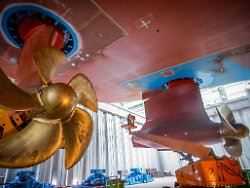Monday, September 6th, 2021
Strong numbers with a big hook
German order books are bursting
Germany’s manufacturing industry can no longer complain about a lack of work. The order books are not only fuller than they were before the crisis, they are as full as they have been for 30 years. Nevertheless, there is no euphoria – because the strong increase in demand is running against equally great hurdles.
The order books in the manufacturing sector are full – but in view of delivery bottlenecks, sales are developing much less strongly. As reported by the Federal Statistical Office in Wiesbaden, incoming orders in the manufacturing sector in July were 3.4 percent higher than in June and thus reached the highest level since the start of the time series in 1991.
According to the Federal Office, the previous high was reached in December 2017 before the Corona crisis. The significant increase compared to the previous month is therefore due to major orders from the shipbuilding sector, among other things. Excluding major orders, there was a decrease of 0.2 percent in July 2021.
Compared to February 2020, the month before the restrictions caused by the corona pandemic in Germany, incoming orders in July were significantly higher with a seasonally and calendar-adjusted increase of 15.7 percent. Compared to July 2020, the same month last year, when incoming orders were still affected by the pandemic, calendar-adjusted orders rose by 24.4 percent.
At the same time, according to preliminary figures from statisticians, real sales in the manufacturing sector in July were 1.9 percent higher than in June 2021 and 4.6 percent lower than in February, the month before the crisis; compared to July 2020, the increase was 5.7 percent. “The trend towards increasing incoming orders with a simultaneous weak sales trend, which has been observed for a few months now, is due, among other things, to the supply bottlenecks of preliminary products reported in many industries,” explained the Federal Office.
No quick recovery in production
The figures showed “that the economic recovery is basically intact”, commented the scientific director of the Institute for Macroeconomics and Business Cycle Research (IMK) of the Hans Böckler Foundation, Sebastian Dullien. “All branches of industry posted incoming orders above pre-crisis levels and demand from both home and abroad was robust.”
However, unlike in earlier recovery phases, it is not to be expected that the strong growth in orders will quickly be reflected in an increase in production. “The manufacturing industry is currently struggling with massive supply problems for primary products and in particular semiconductors and is currently barely able to expand production in the short term,” explained Dullien. “For the first time since reunification, supply-side restrictions should noticeably dampen production growth in the coming months.”
This also has consequences for the economic outlook: The IMK will “in all probability have to lower its forecast for economic growth in the current year from the current 4.5 percent”, explained Dullien. At the same time, the high, unprocessed order backlog of the companies means “that the growth prospects for 2022 are improving”.
.
